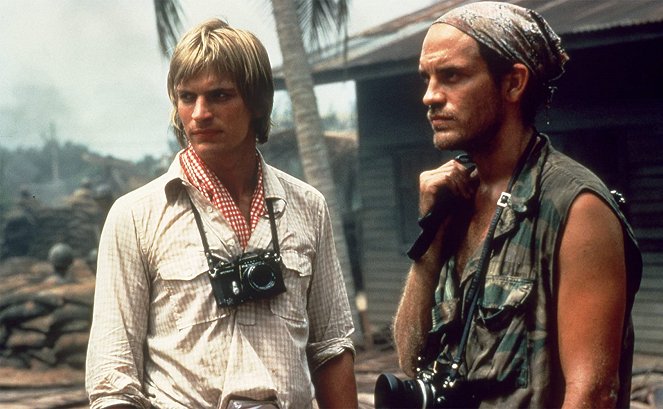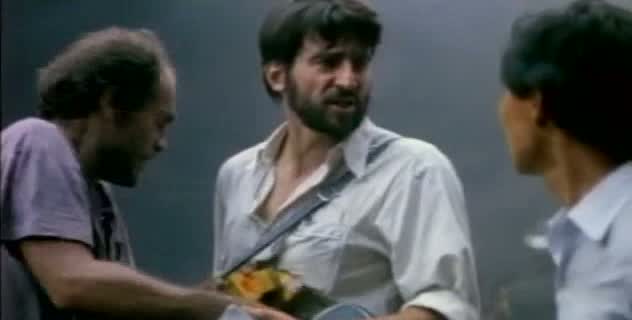Directed by:
Roland JofféScreenplay:
Bruce RobinsonCinematography:
Chris MengesComposer:
Mike OldfieldCast:
Sam Waterston, Haing S. Ngor, John Malkovich, Julian Sands, Craig T. Nelson, Spalding Gray, Bill Paterson, Athol Fugard, Mark Long, Patrick Malahide (more)Plots(1)
A photographer is trapped in Cambodia during tyrant Pol Pot's bloody "Year Zero" cleansing campaign, which claimed the lives of two million "undesirable" civilians. (official distributor synopsis)
Videos (1)
Reviews (9)
The Killing Fields is a movie where ambition simply oozes out of every frame. I’m not saying it’s bad. Especially when it’s in the hands of a director who knows how to avoid cheap sucking up to the Academy (although Lennon at the end was a step way over the mark). In the first half I couldn’t help asking myself why the story revolves round such an uninteresting, self-centered journalist when his gofer who he treats like shit is a hundred times more interesting. And luckily the filmmakers thought this too and in the second half they put him to the fore. And did well to do it in my eyes. Otherwise the scenes like developing photos in Spartan conditions, the video with Nixon’s speech and shots of the atrocities of the Khmer Rouge cut with Vincerò or lost in the killing fields are such powerful scenes that Roland Joffé has earned my greatest admiration. On the other hand, it doesn’t change the fact that I can see mistakes here. Which I can’t say about his next movie, however much I might want to.
()
At first it looks like just a great performance by Sam Waterston, but this film develops incredibly, until you realize that it's an incredibly powerful drama, both socially and humanly. The war is depicted without any embellishment, but we are not on the battlefield for most of the time. This makes the impact on the viewer even greater, who sees the outcome.
()
The first half of the film wasn't uninteresting and I can't say that nothing happened in it, but compared to the second half it was really weak and overly ordinary. I also have some reservations about Oldfield's music, which fits the plot like a glove in places (quiet passages or the dramatic evacuation), but at other times it sticks out and distracts from the film (the captivity of the journalists, for example). As I've already said, everything that is worth seeing in the film happens in the second half - Dit Pran wanders Cambodia (here Rolland Joffé was obviously preparing for the upcoming Mission), Schanberg watches TV at home with Vincero playing, Schanberg searches for Pran... And then, of course, the beautiful ending (of course I feel bad for Lennon). Three and a half.
()
I would make all voters of the Communist Party watch this film, because this is what it looks like when communism is put into practice. Joffé perfectly portrayed the dark atmosphere of genocidal Cambodia under the Khmer Rouge, the communist uniformity and brainwashing makes you sick, many scenes will give you the chills. In Pol Pot’s Cambodia, almost anything was possible in terms of evil and trampling on human dignity, so it is not surprising that even a "little girl with a blue plastic bag" can easily become synonymous with death. The performance of Cambodian non-actor Haing S. Ngor as Dith Pran, an interpreter who experiences the Pol Pot regime first-hand, is riveting and rightfully Oscar-winning. Interesting fact, Haing himself went through the hell of the Pol Pot regime, which makes his performance all the more believable.
()
How is it possible that such powerful content can be expressed through masterful form? With this film, a picture often says more than a few thousand words. Rather than an uncompromising anti-communist agitprop, The Killing Fields is a gripping story about the distressing reunion of two lifelong friends. With great distinctiveness and candor, the first half skillfully captures the disarray of a state affected by the clenched fist of the communist revolution. The second half then shows with what coldness the social stratum of intelligence can be liquidated. The relentlessness of the labor camp, from which there is essentially no escape, then escalates into horrifying images dominated by a little girl with a blue plastic bag, and the subsequent transition to the "killing field." The ending becomes even more powerful and emotional, causing even the toughest person to momentarily forget their toughness and be deeply moved.
()
Gallery (75)
Photo © Warner Bros. Pictures



Ads